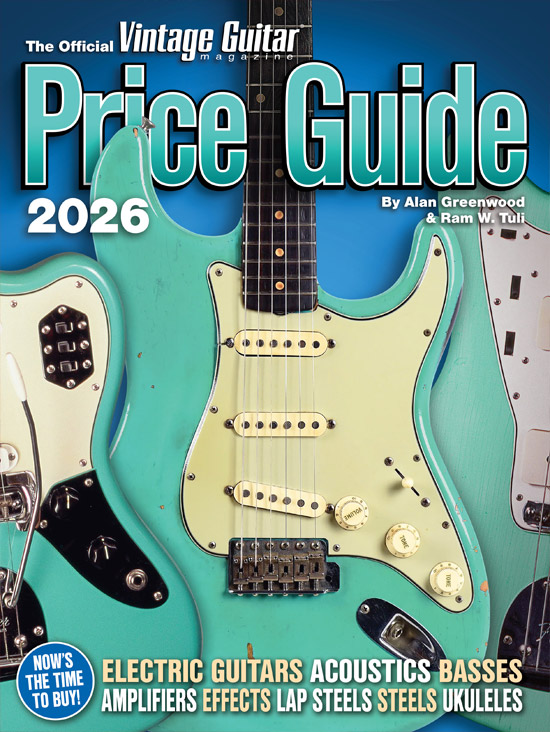
1938 Kay Violin-Style Guitar.
One prominent thread in the story of the guitar is a quest for more volume – a search that was effectively achieved with the dominance of the electric guitar that began in the early 1950s. But it actually started in the 1890s when, influenced by the popularity of mandolin orchestras, guitarists began to replace their gut strings with wire.
The trapeze tailpiece was invented at the same time, to help the guitar’s top support the increased tension created by steel strings. Around the time of World War I, some makers began increasing the size of their guitars; witness Martin’s first “dreadnoughts.” In the 1920s, the Dopyera brothers’ metal-bodied National resonator guitars presented the next solution to the volume dilemma. While electric guitars first appeared following the invention of electronic recording in 1924 (Stromberg-Voisinet’s Electro of 1928 is the first documented, if unsuccessful, electric), the next step in the evolution of the march toward volume was the predominance of the archtop guitar in the 1930s. Paced by companies such as Gibson and Epiphone and individual luthiers such as New York’s John D’Angelico and Boston’s Elmer Stromberg, everyone touted their high-volume archtop guitars, including Stromberg-Voisinet, which had become the Kay Musical Instrument Company by the early ’30s, and was heavily promoting guitars such as this swell Kay Violin-Style archtop guitar from 1938.
By the time this guitar was produced, Kay had become one of the biggest players in the big Chicago guitarmaking game. Why American guitarmaking settled in Chicago has many reasons, but none more important than the presence of the big catalog retailers Montgomery Ward and Sears-Roebuck, both of whom were busy outfitting the recent settlers of the rural heartland breadbasket with every conceivable consumer good, including guitars. The 1890s saw an explosion of manufacturers in Chicago, including the Groehsl Company, founded in 1890. Groehsl thrived, possibly in part by providing guitars for Ward’s, and in 1921 the company changed its name to Stromberg-Voisinet (S-V). In 1924, S-V pioneered the use of laminated woods in guitarmaking, though not all models used the technique. While “plywood” is often disparaged today, at the time it was considered advanced, adding strength and longevity to S-V guitars.
By the late 1920s, S-V’s Secretary was one Henry “Hank” Kay Kuhrmeyer, the man behind the Electro guitar. Another of Hank’s projects may have been S-V’s distinctive, asymmetrical Venetian guitar line, developed by luthiers Philip Gabriel and Joseph Zorzi and introduced circa 1927. These were further developed by Zorzi, turning into round-hole 14-fret archtops (bent, not carved) that were introduced in 1930 or ’31 as the Kay Kraft line. In ’31, Kuhrmeyer became the President and sometime between 1931 and ’34 the company changed its name again to become the Kay Musical Instrument Co.
One unique feature of the Kay Kraft Venetians was a bolt-on neck that allowed you to easily adjust neck tilt and, thereby, the action. Kay’s Kay Kraft Venetian archtops were the top of the line through the early ’30s and were joined in ’33 by the Arch Kraft line of archtops (again bent with round soundholes) with more conventional Spanish body shapes. Also in ’33 Kay introduced two other curious guitars, one a flattop with f-holes centered on the waist, the other an archtop described as having “arched top and back, new Arch Kraft model. Built similar to a violin with f holes, giving it more volume of tone. Rich reddish brown piano gloss finish with strongly contrasted shading, white striped edges, oval fingerboard with 14 frets clear of the body.” In 1934, Kay replaced the Venetians with a line of Spanish-shaped Kay Kraft Deluxe guitars, again with arched tops and round soundholes. All these guitars utilized Zorzi’s adjustable neck design. In ’35, Kay finally landed on a “classic” archtop that anchored its line until the War. These came in various sizes and had a bent (not carved) top, Spanish shape, f-holes on the lower bout, and, finally, a glued-in 14-fret neck with an adjustable bridge for tweaking the action.
In late 1936, Kay began using the Kay brand name and by ’37, the Kay Kraft name was gone.
Which brings us to Kay’s fascinating Violin-Style guitars, “distinctively new and different style guitars” that were offered in 1937 and ’38, primarily through the distributors Tonk Brothers and Continental. Actually, what was new and different about these archtops was the use of “oversize” tops and backs that extended over the rims to provide a “lip” reminiscent of the protruding edges on a violin. These guitars were made of laminated birch and maple veneer with a laminated spruce top that was, as always, pressed rather than carved. The 14-fret necks were set in and featured ebonized hardwood fingerboards. All were finished in a thin “antique violin” brown lacquer. Several variations in headstocks can be found. Some featured a flat, normal width head that ended in a round horizontal scroll similar to those found on some ’60s Baldwin Burns guitars. Others had a very narrow pointy headstock carved into something like a cello scroll head. Still others, as here, had standard flat Kay headstocks.
The use of the extended lips on Kay’s Violin-Styles may have been a clever idea, but basically this is a thin ridge of soft laminated spruce. Bang into a chair or a wall and you’re asking for damage. It’s pretty rare to find one of these without a raggedy edge in places.
Kay Violin-Style guitars were hardly high-end guitars, but then it’s important to remember that this was the Great Depression and few people could afford an expensive Gibson, much less a D’Angelico. Most Kay archtops have a trebly, cutting sound which was, after all, the object of a form intended for breaking through in a dance band. The Violins are no exception – pleasant enough, but don’t expect the response or full volume of a good, professional carved archtop!
Kay’s archtops were pretty well-received among average players, and were the mainstay of Kay’s reputation for many years. Few instruments of any kind were produced once World War II began in 1941, and after the War, Kay returned to archtops for the top of its line, but it was only a matter of time before electric guitars would edge them into relative obscurity. Kay finally went out of business in 1968, though the name is still used on Asian imports. Nevertheless, these Kay Violin-Style guitars remain fascinating examples of an era of hard times, when the archtop
was king.
This article originally appeared in VG‘s Jan. ’07 issue. All copyrights are by the author and Vintage Guitar magazine. Unauthorized replication or use is strictly prohibited.



